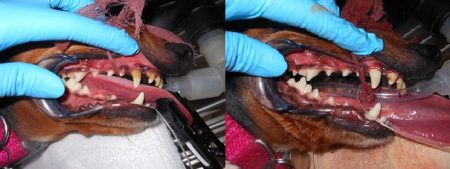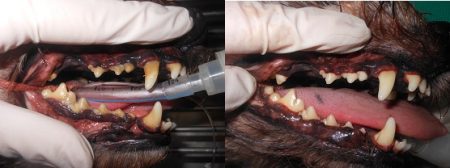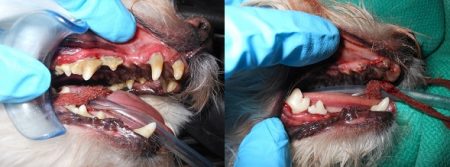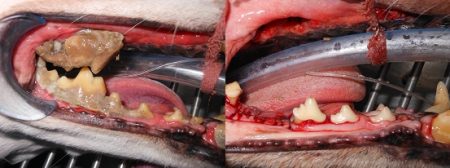Grade 1
The first stage of periodontal disease occurs when bacteria multiply on the tooth’s surface and under the gum line forming plaque. Eventually plaque mineralizes and hardens, becoming calculus. Plaque, calculus, and the toxins produced by the bacteria irritate the gums causing them to become tender, swollen, and red. This is referred to as gingivitis.
Because your pet still has mild periodontal disease we recommended that you address it now before it worsens. The picture below is the mouth of a 5 year old Dachshund before and after professional dental cleaning.

Grade 2
In Grade two periodontal disease the amount of visible tartar varies, however, inflammation of the gums and the development of tartar under the gum line is beginning. These changes are caused by bacteria in the plaque under the gumline. If the plaque remains and the gingivitis is not treated, deeper infection follows, causing breakdown of the tissues that hold the tooth in its socket.
Inflamed gums such as these may be painful, and an odor may be more apparent as infection progresses. The bacteria associated with periodontal disease constantly enter the bloodstream and travel to internal organs often causing damage to the heart, kidneys, and liver.
Before and after pictures of a fourteen year old Cairn Terrier with Grade 2 disease.

Grade 3
Once a pet has progressed beyond grade two periodontal disease, the dental cleaning falls into a therapeutic treatment and becomes much more involved and expensive. Dental disease beyond this stage is not reversible, and treatment is then aimed at slowing the progression of dental disease, and minimizing the serious effects on vital organs.
Dental disease at this stage affects more than the mouth. The simple act of chewing on a piece of food causes the gums to bleed and provides an opportunity for bacteria to enter the bloodstream. From the mouth, the bacteria easily travel to the vital organs such as the liver, kidneys, and heart.
During this stage, deep cleaning and periodontal surgery may be needed to save affected teeth. Extractions may be indicated of more severely affected teeth. If allowed to progress to grade 4 periodontal disease, many teeth may loosen due to complete destruction of the supporting bone, and the ongoing source of infection continues to damage vital organs.
Immediate treatment is strongly encouraged at this time to slow the progression of dental disease, reduce or eliminate pain, and minimize any further internal organ damage.
Before and after pictures of a five year old Maltese with Grade 3 dental disease and tooth loss.

Grade 4
The inflamed gums eventually pull away from the teeth, creating periodontal pockets beneath the gum line. Bacteria flourish in these pockets, significantly weakening the supporting structures and the bone of the jaw. The simple act of chewing on a piece of food causes the gums to bleed and provides an opportunity for bacteria to enter the bloodstream. From the mouth, the bacteria easily travel to the vital organs such as the liver, kidneys, and heart.
During this stage, deep cleaning and periodontal surgery may be needed to save affected teeth. Extractions may be indicated of more severely affected teeth. If not treated, grade 4 periodontal disease will progress damaging more teeth, supporting bone, and internal organs.
Immediate treatment is strongly encouraged at this time to stop progressive dental disease and prevent any further internal organ damage.
Before and after pictures of a thirteen year old Greyhound with Grade 4 disease and tooth loss.

